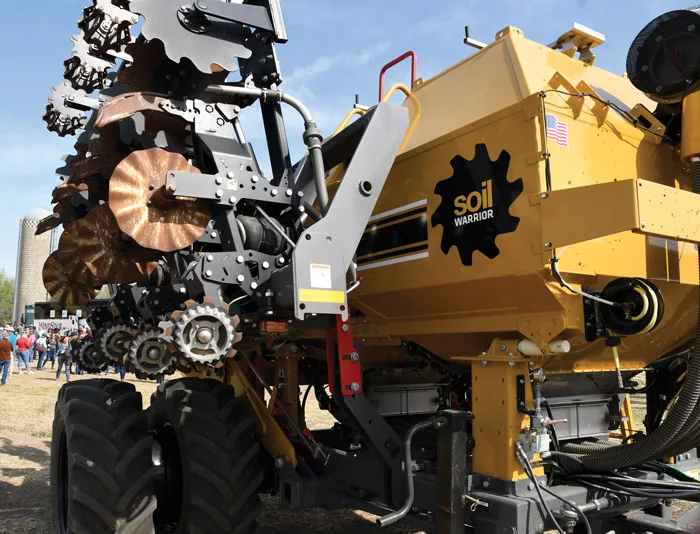From ethanol to cover crops to equipment innovations, the changing, dynamic world of conservation agriculture was on full display as the 2025 Conservation in Action Tour trekked across South Dakota.
Hosted by the Conservation Technology Information Center (CTIC), the tour included a visit to Ryan and Christina Larson’s 1,000-acre strip-till and no-till operation in Garretson, S.D., near the southwestern Minnesota border.
Ditching Tillage
After graduating from South Dakota State Univ. (SDSU) with an agronomy degree, Ryan Larson wanted to farm on his own. He got his start on 100 acres that his family still owned, using a $1,500 sprayer, a decades old Allis-Chalmers tractor and other old tillage equipment for doing a conventional tillage system.
“I just kept continually buying and fixing old, junky equipment. We were discing, field cultivating, going over everything at least twice, burning lots of fuel. I didn’t like what we were doing,” Larson told attendees during his presentation. “We were getting a lot of erosion. The profitability and yields weren’t that good.”
“The lower the soil test values are, the stronger the response because you’ve got that extra boost of nutrition in the strip…”
He decided to join the South Dakota Soil Health Coalition, after talking with SDSU Soils Field Specialist Anthony Bly and watching No-Till Legend Dwayne Beck’s YouTube videos. Larson started out no-tilling soybeans, joined the EQIP program and added oats, soft white winter wheat and cover crops to his rotation. He also added livestock to the operation.
“Years after that, everything really changed. The soil got much better, and the subsequent crops were way more profitable than before,” Larson says. “So, we sold the field cultivator and basically quit doing tillage.”
Strip-Till Switch
No-tilling corn on some of his ground was a challenge due to soil types and previous erosion and abuse. Larson borrowed a neighbor’s strip-till rig and started banding fertilizer in the corn in poorer fields while no-tilling the rest.
Larson is now using an Environmental Tillage Systems (ETS) SoilWarrior to strip-till two-thirds of his corn crop and no-tilling a third of it. He’s liking the results so far.
“Strip-till really boosted our yields and decreased the amount of fertilizer I needed,” Larson says. “It bridged the gap between transitioning from poorer fields to no-tilled fields, as the soil was getting in shape, building structure, things like that.”
Hefty Insights
Darren Hefty, a farmer, agronomist and co-owner of Hefty Seed Co., was also on hand during the tour to further discuss the benefits of strip-till. He says the practice has a lot of advantages for growers who are serious about boosting corn production efficiently and effectively.
“One of the positive things about fertilizer placement with strip-till is the lower your soil test values are, the stronger response that you have because you’ve got that extra boost of nutrition there in the strip,” he told attendees. “If you’ve got rented ground where you’re on a year-to-year basis, strip-till lets you put the fertilizer where the crop is most likely to extract it, so they can get most of the value out of the investments that they’re making.”
“Strip-till really boosted our yields and decreased the amount of fertilizer I needed…”
Drawing on his experience with a field he owns, Hefty says strip-till can work well in soils with a high pH where nutrient tie-up could be an issue.
“By keeping the nutrients fairly concentrated, we’ve got a better chance of them staying available for our crop.”
Q&A Session
Larson fielded questions about his operation from over 100 attendees during the tour of his farm. Here are a few highlights from the conversation.
How much of a safety net and flexibility did the EQIP funding give you?
“Honestly, if I wasn’t in that first EQIP program, I might not have been pushed hard enough to do that third crop on the scale that I did,” Larson says. “There was one point where I almost had half my acres into a small grain and had cover crops behind it. That year, we only fed cows for about 6 weeks, and that was when the frost was coming out and it was getting muddy. The cover crops, small grains and cows, they all complemented each other so well, I learned. The whole system just came together.”
What’s your goal with cover crops?
“Get rid of compaction, get the soil in shape, build organic matter and increase water infiltration,” Larson says. “The list goes on and on. After small grains, we’ll plant anywhere from 9-15 different cover crop species. I try to keep it mostly grasses just to keep the biomass high in the soil and get the most biomass for grazing as well. I will also throw some clovers and flax in there. There will be barley, oats, winter wheat, rye, turnips and radishes. The small grains really take care of that soil compaction and all the hard pans that have been built up over the years from tillage.”
What’s the biggest challenge you’re currently trying to overcome?
“Managing our soil nutrient levels and trying to find the happy medium between maintaining yields and not going broke at the same time,” Larson says. “Staying profitable while keeping the lights on is always the biggest challenge — growing a crop and having something to sell.”
What are some of the benefits you’ve seen from grazing cover crops?
“The cows cover up all your mistakes,” Larson says. “If you mess up a field, they’ll just graze it. It really makes the small grains profitable, too, because there’s less feed you have to use. They’re cycling all those nutrients and spreading their own manure. I don’t need a manure spreader hardly at all.”








